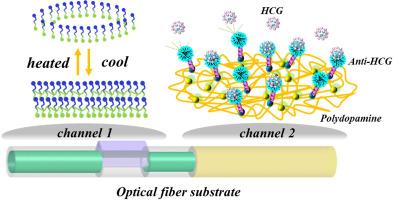Dual-mode optical fiber sensor with polydopamine-functionalized surface and PDMS-enhanced temperature compensation for ultrasensitive HCG detection
IF 5.7
3区 材料科学
Q2 MATERIALS SCIENCE, MULTIDISCIPLINARY
引用次数: 0
Abstract
This study introduces a temperature-compensated dual-mode optical fiber sensor for ultrasensitive human chorionic gonadotropin (HCG) detection, integrating polydopamine (PDA) nanostructures with polydimethylsiloxane (PDMS)-modified microcavities. The hybrid design synergistically enhances surface plasmon resonance (SPR) and Fabry-Pérot (FP) responses through engineered material interfaces. PDA enables efficient antibody immobilization via amine coupling, while PDMS simultaneously acts as a thermal expansion compensator and optical phase modulator, overcoming temperature-induced signal drift in conventional biosensors. The system demonstrates dual refractive index sensitivity (1875 nm/RIU) and differentiated temperature responses (-0.12 nm/ °C SPR vs. -0.61 nm/ °C FP), enabling environmental decoupling through matrix analysis. The sensor achieves record HCG detection performance with 1.54 nm/(mIU/mL) sensitivity and 0.01 mIU/mL detection limit. This materials-driven approach merges functional polymer engineering with photonic design, establishing a new paradigm for field-deployable lab-on-fiber biosensors. The work advances multiplexed optical sensing technologies for point-of-care diagnostics and smart medical materials development.

基于聚多巴胺功能化表面和pdms增强温度补偿的双模光纤传感器用于超灵敏HCG检测
本研究介绍了一种用于超灵敏人绒毛膜促性腺激素(HCG)检测的温度补偿双模光纤传感器,该传感器集成了聚多巴胺(PDA)纳米结构和聚二甲基硅氧烷(PDMS)修饰的微腔。混合设计通过工程材料界面协同增强表面等离子体共振(SPR)和法布里-帕姆罗特(FP)响应。PDA通过胺偶联实现有效的抗体固定,而PDMS同时作为热膨胀补偿器和光学相位调制器,克服了传统生物传感器中温度引起的信号漂移。该系统具有双折射率灵敏度(1875 nm/RIU)和不同的温度响应(-0.12 nm/°C SPR vs -0.61 nm/°C FP),通过矩阵分析实现环境解耦。该传感器以1.54 nm/(mIU/mL)的灵敏度和0.01 mIU/mL的检出限实现了创纪录的HCG检测性能。这种材料驱动的方法将功能聚合物工程与光子设计相结合,为现场可部署的实验室光纤生物传感器建立了新的范例。这项工作推进了用于即时诊断和智能医疗材料开发的多路光传感技术。
本文章由计算机程序翻译,如有差异,请以英文原文为准。
求助全文
约1分钟内获得全文
求助全文
来源期刊

Materials Research Bulletin
工程技术-材料科学:综合
CiteScore
9.80
自引率
5.60%
发文量
372
审稿时长
42 days
期刊介绍:
Materials Research Bulletin is an international journal reporting high-impact research on processing-structure-property relationships in functional materials and nanomaterials with interesting electronic, magnetic, optical, thermal, mechanical or catalytic properties. Papers purely on thermodynamics or theoretical calculations (e.g., density functional theory) do not fall within the scope of the journal unless they also demonstrate a clear link to physical properties. Topics covered include functional materials (e.g., dielectrics, pyroelectrics, piezoelectrics, ferroelectrics, relaxors, thermoelectrics, etc.); electrochemistry and solid-state ionics (e.g., photovoltaics, batteries, sensors, and fuel cells); nanomaterials, graphene, and nanocomposites; luminescence and photocatalysis; crystal-structure and defect-structure analysis; novel electronics; non-crystalline solids; flexible electronics; protein-material interactions; and polymeric ion-exchange membranes.
 求助内容:
求助内容: 应助结果提醒方式:
应助结果提醒方式:


